Introduction
Mercury, our solar system’s innermost planet, is shrouded in mystery, despite the fact that it is Earth’s third closest planetary neighbor and is one of the five planets known to the ancients. It is fairly easy to see. It appears to an Earth-based observer at approximately 2-month intervals as a bright object visible to the naked eye near the Sun, shortly before sunrise or after sunset. However, despite its nearness and its brightness, it ranks only behind the most distant planet, Pluto, in our understanding of its interior structure, its surface composition, and the dynamic interactions between its surface, its tenuous atmosphere, and its magnetosphere. The physical processes that have governed Mercury’s origin and evolution are poorly understood. The planet has many unusual qualities, including an unexpected magnetic field and a remarkably high density (mass to volume ratio). It has even been suggested that water ice may be present just under the surface at some places on the planet, even though its surface is the closest to the Sun of all of the planets. Because Mercury is close to the Sun, the response of the planet’s environment to solar activity is also expected to be greatest of all of the planets.
Mercury stands out as an object of intense scientific interest because it represents an extreme within the family of planets. It formed at the highest temperature of all of the objects that condensed from the presolar nebula. As the closest planet to the Sun, it supports an environment that tests the limits of current theories of comparative planetology. Its surface experiences wide extremes in temperature because the planet rotates slowly in a period of 59 days and revolves about the Sun every 88 days. This 2:3 ratio of rotational period to period of revolution creates a dawn-to-dawn Mercurian day of 176 Earth days, the longest day in the solar system. The dayside equatorial temperature approaches 700 K, among the highest of any planetary surface in the solar system. When day turns to night, the temperature plunges rapidly, and the surface becomes as cold as the unilluminated side of the Moon (100 K). This is the most extreme daily temperature fluctuation of all of the planets. Understanding more about Mercury is important for testing models of planetary formation, and the results of these research activities will have great impact on models of the origin and evolution of the solar system. The basic physical properties of Mercury are shown in Table 1.
History of Exploration
The observations of the ancients did not reveal much about the surface of Mercury. Even though the planet appears bright to the naked eye, it is sufficiently far away that no surface detail can be seen. The ancients were able only to map its motion in the sky. The use of the telescope, pioneered by Galileo in 1610, did not add much to what was already known by the ancients because Mercury, as the innermost planet, is never more than 27° from the Sun as seen projected on the celestial sphere from the perspective of an Earth-based observer. From Earth, the planet can either be observed during the day, when scattered sunlight provides a strong source of background noise, or low in the sky while contaminated by background signal from Earth’s atmosphere when the Sun is just over the horizon, shortly before sunrise or after sunset. In this case, as Mercury approaches the horizon, the light must pass through 5-10 times as much turbulent air as when it is observed overhead. This limits the ability of ground-based astronomers to observe Mercury. Thus, the typical spatial resolution obtainable on Mercury even with the best Earth-based telescopes is just a few hundred km, far worse than can be seen on the Moon by the unaided eye.
Table 1. Physical Properties of Mercury3
| Mass 3.301 x 1023kg Mass relative to Earth 0.0554 Semimajor axis 0.387099 x 106km Eccentricity 0.205628 Inclination to ecliptic 7° 0′ 15″ Radius 2425 km Bulk density 5.44 g/cc Sidereal period 87.969 days Period of rotation 58.646 days Surface gravitational acceleration 363 cm/s2 Escape velocity 4.2 km/s Dipole magnetic moment 2-6 x 1012 Tm3 |
The modern generation of space-based observatories, pioneered principally by the International Ultraviolet Explorer and currently dominated by the Hubble Space Telescope, are not limited by the atmospheric distortion problems of observing Mercury from Earth. However, both of these space-based observation platforms are constrained from pointing near the Sun due to the concerns of spacecraft engineers that direct rays of the Sun might pass down the telescope and damage the sensitive optical instruments. Given these difficult geometric observing constraints, it is difficult to enhance vastly our understanding of Mercury using available observing techniques from Earth’s surface or from near-Earth orbit.
Despite these problems, terrestrial observing has produced some interesting results. For example, in 1955, astronomers reflected radar waves from Mercury’s surface. By measuring the Doppler shift in the frequency of the returned radiation, it was established that Mercury has a 59-day rotational period, two-thirds that of its 88-day orbital period of revolution. Until then, it had been thought that Mercury had an 88-day rotational period, identical to its period of revolution about the Sun. It had been assumed that Mercury was in synchronous rotation about the Sun just as the Moon is about Earth. This finding proved to be just one prelude to the many surprises from Mariner 10, two decades later (2).
The Mariner 10 Mission
Mariner 10, the Mercury-Venus flyby mission, elevated our understanding of Mercury from almost nothing to most of what we presently know. Getting Mariner to Mercury was not a trivial task. The planet’s orbit lies deep in the gravitational potential well of the Sun, and therefore Mariner flew by Venus to exchange gravitational energy and thus slow the spacecraft for a Mercury encounter. The heliocentric orbit provided three close flybys of Mercury on 29 March 1974, 21 September 1974, and 16 March 1975. The spacecraft carried an ensemble of instruments intended to address fundamental questions about the planet’s current physical state, its origin, and subsequent evolution.
The Mariner imaging system was based on the most current television technology available when the mission was conceived. The spacecraft returned to Earth approximately 2000 images of about 45% of the planet. The resolution of the images was about 1.5 km, comparable to that of the Moon when viewed from Earth through a telescope. The other side of Mercury, more than half the planet, has never been seen. Despite Mariner’s accomplishments, our present understanding of Mercury remains limited. We know as much about Mercury today as we knew about our own Moon at the dawn of the space program (3,4).
Mercury’s Unusual Density
Mariner results confirmed that one of Mercury’s most unusual distinguishing characteristics is its remarkably high bulk density, the planet’s mass divided by its volume. It was found that Mercury’s density is 5.44grams/cc, remarkably greater than its apparent surficial likeness, the Moon. It has been known since the time of Archimedes that density differences measured between objects imply that the objects have different physical states and/or chemical compositions. Except for Mercury, the terrestrial planets (Venus, Moon, Mars, and Earth) all exhibit a fairly linear relationship between density and size. Figure 1 illustrates this point. The largest terrestrial planets, Earth and Venus, have the highest density; the smaller ones, Moon and Mars, have densities that are much lower. However, Mercury is unique. It is relatively small, comparable to the Moon and Mars, but its density is typical of that expected from a much larger planet such as Earth or Venus. This density ”anomaly” is an important gateway to understanding Mercury’s interior.
Planets, in general, do not have homogeneous interiors. The outer layers are usually composed of low-density materials such as silicate rocks whose density is about 3 gm/cc. However, the density of a planetary interior increases with depth due to the compression created by the overlying rock layers and gravitational fractionation of the materials that comprise the interior. This causes the densest material to become concentrated at the center. Based on our understanding of the cosmic abundance of the elements, it is generally accepted that the high density materials that comprise the cores of the planets are extremely rich in iron and may even contain pure iron in some cases. Density considerations strongly suggest that Mercury has the largest core relative to planetary size of all of the terrestrial planets. This fact has stimulated a lively debate regarding the processes that governed the origin and evolution of the solar system.
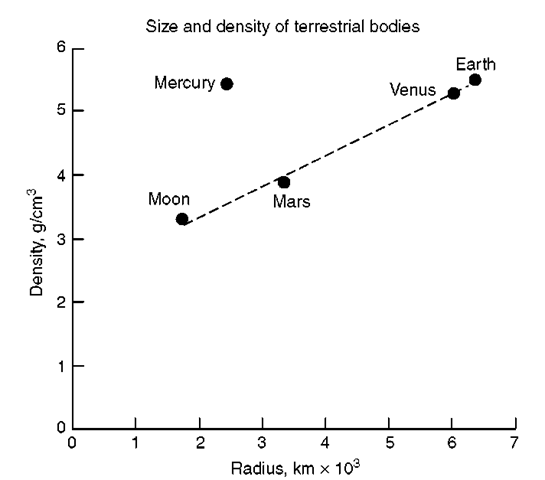
Figure 1. It has been known since the time of Archimedes that the density of an object yields important information about the object’s internal constitution. Archimedes used this principle to determine the gold content in the crown of a monarch, but the density of Mercury shows that it is unique among the terrestrial planets. The other terrestrial planets conform to a linear relationship between size and density. Mercury, however, is relatively small, yet its density is comparable to that of large objects like Earth and Venus. This has been understood to mean that Mercury has a very large core comprised mostly of iron, a very dense material, and a relatively thin crust of lower density silicates.
The unique internal structure of Mercury is a fundamental constraint on models of its origin and evolution, and these models, in turn, constrain the models of solar system formation. Mercury’s bulk density (5.44 g/cc), which rivals that of Earth (5.52 g/cc) and Venus (5.25 g/cc), is furthermore unusual when the effect of the relatively larger masses of Earth and Venus are considered. The larger objects have greater overburdens that compress the interiors of Earth and Venus more than Mercury’s smaller exterior mass compresses its interior. When this compressional effect is considered, Mercury, it is found, has the largest uncompressed density (5.3 g/cc) of all of the terrestrial planets. (Earth’s uncompressed density is about 4.4 g/cc) (5). This can best be explained by assuming that Mercury has the largest fraction of iron of all of the terrestrial planets and the Moon. Mercury’s core, where the iron is concentrated, is about three-fourths the size of the entire planet. For comparison, Earth’s core is about half its total size.
The current hypothesis of solar system formation holds that all of the planets condensed from the solar nebula at about the same time. If this is true then, one of three circumstances may have occurred that made Mercury so different from the other terrestrial planets. First, the composition of the solar nebula might have changed dramatically from the vicinity of Mercury’s orbit to the regions of the other terrestrial planets, and this change may have been much larger than theoretical models would predict; second, early in the lifetime of the solar system, the Sun’s energy was so great that a large fraction of the more volatile, low-density elements on Mercury were vaporized and driven off; or third, Mercury suffered a catastrophic episode, such as a collision with a very massive object some time after it formed, which drove off the less dense materials. Another catastrophic possibility is that Mercury formed elsewhere in the solar system and was moved to its present location by a random act of violence. All of these very different hypotheses can be entertained, given the current body of evidence. Future missions to Mercury are expected to help resolve these issues.
Mercury’s Strong Magnetic Field. Mariner 10 made three close passes by Mercury; two of were at altitudes of 300 and 700 km. The magnetometer on the spacecraft measured magnetic field strengths of 100-400 nT. This yields a dipole magnetic moment of ~4 x 1012Tm3. Mercury’s dipole magnetic field is among the largest of those of all of the terrestrial planets, except Earth. This field is represented by the lines shown in Fig. 2. It is generally believed that Earth’s magnetic field is supported by electric generator-like processes that occur in the liquid circulating in Earth’s interior and that a field is produced as a consequence of the relative motions between the conducting regions in the interior. If Mercury’s magnetic field has a similar origin, then this would imply that the planet has a liquid core (6). However, small objects like Mercury have a higher proportion of surface area compared to volume than the larger planets and therefore, other factors being equal, small bodies dissipate their energy to space faster. If Mercury has an iron core, as the density and magnetic field data imply, then a pure iron core should have solidified eons ago. Yet, a solid core could not support a self-sustaining dynamo to create a magnetic field. In response to this apparent contradiction, it has been proposed that other materials are probably present in the core and, along with iron, these additional materials form a eutectic with the iron which depresses the freezing point, just as antifreeze depresses the freezing point of water in an automobile radiator. Sulfur, a cosmically abundant element, has been suggested as a possible candidate which, when combined with iron, would keep Mercury’s core liquid at a much lower temperature than would be expected from a pure iron core alone. If so, then the dynamo process could sustain a magnetic field (7).
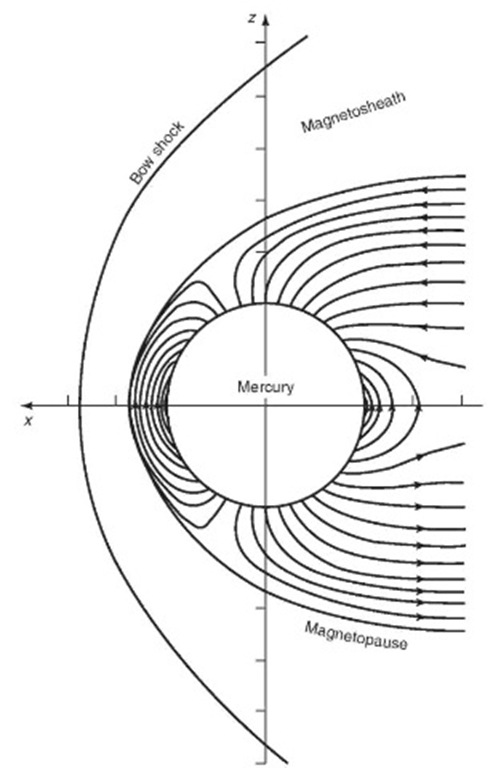
Figure 2. Mercury has a relatively strong dipole magnetic field. Earth is the only terrestrial planet with a larger field. Dipole magnetic fields, it is believed, originate from the motion of liquid materials in a planet’s interior. The presence of the field implies that Mercury has a partially molten core. This is surprising because objects as small as Mercury would be expected to have solidified aeons ago. The magnetic field traps electrically charged particles about Mercury forming a magnetosphere. The magnetosphere is constantly being deformed by the solar wind, a flow of particles streaming out from the Sun. At times, the solar wind becomes so intense, that it pierces the magnetic field and directly touches the planet’s surface. This creates a constantly changing physical environment for the material comprising the surface.
Mercury’s Surface Composition. The high abundance of iron in Mercury’s interior is in sharp contrast to the apparent dearth of iron in the planet’s crust. Careful photometric analysis of the Mariner data along with laborious spectroscopic telescope observations from Earth have failed to detect even trace amounts of iron in Mercury’s crustal rocks. On the other hand, iron has been detected by spectroscopic observations of the surfaces of the Moon and Mars, and, it is known, to be present in the crustal rocks of Earth. This implies that Mercury is one of the most differentiated objects in the solar system, with all of the high-density materials such as iron being concentrated in the interior, and only the low-density silicates being present in the crust.
Iron is evident in the reflection spectrum of lunar rocks by an absorption feature at 0.95 microns. This feature has also been measured in the spectrum of returned lunar samples measured in the laboratory. It is also seen in the spectra of iron oxides of terrestrial origin. There have been reports in the literature that this 0.95-micron absorption feature has been seen on Mercury; however, it has been argued that all of the spectra that report this feature are compromised by the incomplete removal of features caused by the terrestrial atmosphere, which also absorbs in the same spectral region. To date, no positive uncompromised evidence exists for this spectral feature. Observations at microwave wavelengths (7) and mid infrared spectroscopy (8) have been interpreted as inconsistent with iron being present in the crust in a fashion similar to the lunar crust. If Mercury does not have iron-bearing minerals in its crust, then the obvious interpretation of this result is that the iron on Mercury is very strongly concentrated in the planet’s interior rather than on the surface (10).
Alternatively, Mercury’s surface is often exposed to the highly reducing effect of bombardment by the solar wind. This reduces iron oxides to pure metallic iron which does not exhibit the spectral feature at 0.95 microns.
The intensity of light reflected from a typical planetary surface changes as the angle of illumination (incidence) and observation (emission) change. The rate of this change depends on the surface composition and texture. Although a comprehensive photometric study of Mercury’s surface awaits a Mercury orbiter mission, the limited Mariner data set finds little to distinguish Mercury’s photometric properties from those of the Moon (11). Normal reflectances derived for different geologic regimes on Mercury are between 0.09 and 0.45. The range in reflectances observed in lunar materials is similar and ranges from 0.05-0.40 in some areas. However, the dark areas of the Moon are darker than the darkest areas of Mercury. Given the vast differences in the quality of the data sets used for photometric analyses of both bodies, these differences may not be of major significance.
However, Mercury has yet to be studied at a wide range of different angles of illumination and emission; this task will fall to future orbiter missions that will measure the scattering properties of Mercury’s surface from very small to very large phase angles.
If it is found after a full photometric study is completed, that the surfaces of the Moon and Mercury have similar photometric properties, the result might still not be considered unusual. Even if the Moon and Mercury evolved along very different paths, the evolution of the surfaces of both bodies may have been driven by similar processes in recent epochs, creating an evolutionary convergence imposed by similar environmental circumstance.
Mercury’s Geologic History
A cursory glance at an image of the surface of Mercury shows a remarkably lunar-like morphology. The surface is dominated by craters; the largest is Caloris, 1300 km in diameter. The crater density increases with decreasing size to the lowest limit of the Mariner 10 cameras.
The floors of the larger crater basins are less cratered than the immediately surrounding terrain, consistent with the hypothesis that these largest basins are younger in age. The surface is also marked with lineament features and a unique set of thrust faults, or lobate scarps, that may be due to a global change in shape which occurred after the surface had solidified.
Careful inspection of the Mariner 10 images of Mercury’s surface found no evidence for currently active volcanism. It is generally believed that large-scale volcanic processes on Mercury’s surface ended with the heavy cratering episode that concluded the solar system’s planetary formation phase which ended about 4 billion years ago. More recent lava flows on Mercury have occurred on only a small scale, as shown in Fig. 3 and are associated with impacts rather than internal processes (12).
Once planetary surfaces solidify, they no longer exhibit substantive viscous behavior. Instead, when subjected to external forces, the surface either responds elastically or else it fractures as a brittle solid. A planetary surface, that behaves this way is called a lithosphere. The paucity of volcanic activity on Mercury has preserved a record of the earliest tectonic events that occurred shortly after its brittle lithosphere developed. This preservation of tectonic events that occurred early in Mercury’s history is a record that was obliterated or overprinted and obscured on the larger more active planets.
Mercury has several large craters that are surrounded by multiringed material of which Caloris is the largest. This 1300-km diameter behemoth it is estimated, was formed 3.6 billion years ago. It serves as a Mercurian geologic reference indicator because its effects are widespread and define a relative single reference point in time. The antipode of Caloris is characterized by hilly and lineated terrain, suggesting that the impact was so catastrophic that disruption of the surface may have occurred on the side of Mercury opposite the impact.
Mercury’s surface is crosscut by rectangular features of unknown origin, that are preferentially oriented north-south, northeast-southwest, and northwest-southeast. These lineaments are called the Mercurian grid. A probable explanation of the lineament pattern is that Mercury’s crust solidified at a time when the planet was rotating much faster, perhaps only about 20 hours. The model posits that the crust would have solidified while the planet was rapidly spinning and the forces of hydrostatic equilibrium would have created an equatorial bulge, characteristic of a rapidly rotating, self-gravitating object. After the planet slowed to its present rotational period, gravity pulled it into a more spherical shape. The lineaments it is thought, were created as the lithosphere accommodated the new gravitational environment. It has been noted that the lineaments do not cut across the huge Caloris crater, indicating that the Caloris event occurred after the lineament structure had been established (see Fig. 4).

Figure 3. Petrach crater is a relatively recent addition to Mercury’s surface. This is evidenced by the relative paucity of craters, compared to the surrounding terrain. The event that created Petrach may have melted so much rock that lava may have flowed through a channel and flooded the crater about 100 km away.
While Mercury was rotationally slowing, it was also cooling. It is thought that at least part of the core solidified. The core shrinkage that accompanied this solidification probably resulted in a net decrease of about a million square kilometers in surface area. This decline in lithospheric surface area would have produced the network of thrust faults that are expressed as a series of lobate scarps that crisscross Mercury’s surface. It has also been noted that the network of lobate scarps has a fortuitous orientation with respect to Caloris and may be an expression of lithospheric response to such a catastrophic impact. See Figs. 5 and 6.
These depictions of Mercury’s geologic history have been constructed in the absence of accurate age estimates for the geologic units that comprise the surface. The only way in which the absolute age of a rock can be determined is by radiometric dating of returned samples. Geologists, however, have numerous ingenious ways of determining the relative ages of surface units, mostly based on the principle of superposition, which, simply stated, is that a feature that overlies or cuts across another is the younger of the two features. This principle is particularly helpful in determining the relative ages of craters.
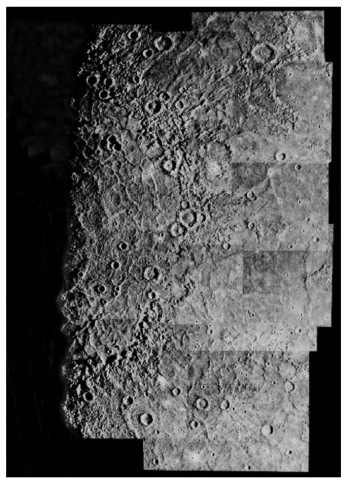
Figure 4. The Caloris basin is one of the largest craters on any object in the solar system. It spans 1300 km in diameter. Cratering statistics indicate that the Caloris impact was relatively recent in Mercury’s history, not part of the heavy bombardment that occurred early in the history of the solar system. The reason for this is that Caloris’ features cover the lineated grid across much of Mercury’s surface. It is believed that the grid pattern resulted from cracking of Mercury’s lithosphere due to slowing of the planet’s rotation early in its history.
Throughout the solar system, planets, planetary satellites, and other smaller solid surface bodies show widespread evidence of impacts from still smaller objects. Even our own planet Earth, where the constant effects of erosion and the slow drift of the tectonic plates tends to erase surface features, shows many craters on its surface. The objects that create these craters typically strike the surface at velocities in the neighborhood of 10 km/s, fast enough to vaporize the impacting object along with a significant amount of planetary material.
The final shape of a crater is related to the physical properties of the imp-actor, its velocity, angle of impact, and the properties of the material in which the crater is excavated. To first order, the size of a crater is related to the energy of the impact. Kinetic energy is a function of mass and velocity. Therefore, the larger and faster impactors cause the largest craters. Study of the important crater features such as size, depth and height of the central peak, slope of the rim walls, provides information about conditions at the time of the impact.
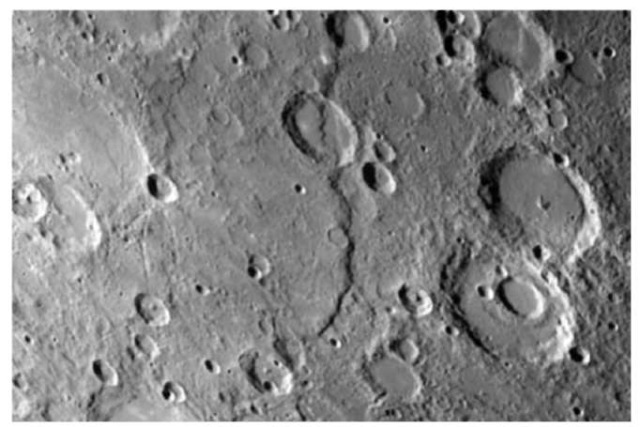
Figure 5. Discovery scarp is typical of the scarps on Mercury. The scarps are younger than many of the craters that are on Mercury’s surface. Therefore, it is observed that they cut across them. These scarps it is believed, are thrust faults that were created by crustal shrinking of the planet as the core partially solidified.
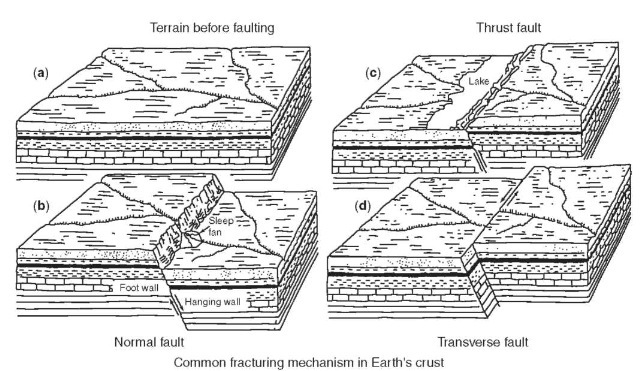
Figure 6. The motion of the relative blocks of crustal material is illustrated in the attached schematic of the common faulting mechanisms on Earth. (a) The unbroken terrain prior to faulting. (b) A simple or normal fault caused by the surface stretching or pulling apart. (c) A thrust fault that is created when the crust is compressed. (d) A transverse fault typical of those found on Earth where continental plates are moving laterally to each other. Mercury’s surface is riddled with thrust faults, which indicates that its crust shrank relatively late in its history.
The size-frequency distribution of craters is a most useful measure for a comparative planetology assessment. The heavily cratered highland surfaces of Mercury, Mars, and the Moon are the product of the period of late heavy bombardment period in solar system history. The three planets have similar crater size-frequency distributions but the relative sizes of the Mercurian craters are larger indicating that the impacting objects had a higher velocity when they struck Mercury. This is expected, given that the laws of kinematics dictate that objects in gravitationally bound, elliptical orbits move about the Sun move faster when they are near the Sun. Therefore, when these objects impact Mercury, which is closer to the Sun than the other planets, they have a relatively higher velocity and hence they create a larger crater size relative to the impacting object’s size. This is consistent with the hypothesis that these impacts were from the same family of objects in orbit about the Sun. The dissimilarity of the crater populations seen on the surfaces of bodies in the inner solar system and the outer solar system indicates that the objects that impacted the inner planets were from a distinct parent group that did not extend beyond Mars to the outer solar system.
Mercury’s Tenuous Atmosphere
Planetary atmospheres are described as thick or thin on the basis of the density of the atmospheric gases and their temperatures. The important discriminator between a thick atmosphere and a thin atmosphere is the mean free path of the atmospheric molecules. The mean free path is the mean distance that the average particle travels before colliding with another particle. Planets that are as hot as Mercury do not retain appreciable atmospheres because the thermal motions of the low molecular weight volatiles exceed the escape velocity from the planet. The density ofthe remaining gases is so low that the individual molecules move on ballistic trajectories. The probability of collisions between individual molecules is small. By analogy, high above the surface of Earth, the density of atmospheric gases becomes so low that the few atmospheric particles present move similarly on ballistic trajectories. The part of an atmosphere that meets this condition is called the exosphere. On Earth, the exosphere begins about 500 km above the surface (13). On Mercury, the entire atmosphere is the exosphere.
Because of the high temperatures, it was expected that any significant amount of volatile material on Mercury would soon be lost to space, and hence, it had long been thought that the planet did not have an atmosphere at all. The atmospheric gases are hot and therefore the particles move at high velocity. The particles that comprise Mercury’s atmosphere travel in ballistic trajectories and their courses are altered only by Mercury’s gravity and collisions with its surface.
However, the ultraviolet spectrometer on Mariner 10 did detect small amounts of hydrogen, helium, and oxygen, and subsequent Earth-based observations have detected small amounts of sodium and potassium (14). The source and ultimate fate of this atmospheric material is a subject of lively discussion within the scientific community (see Fig. 7). Much of the atmosphere is probably due to the action of thermal evaporation and to the effect of the solar wind, a stream of energetic particles, which on occasion directly bombards Mercury’s illuminated side. The solar wind is 10 times greater at Mercury’s orbit than it is at Earth. These particles can remove material from Mercury’s surface by the process of sputtering. Once an atom is sputtered off the surface it becomes part of Mercury’s tenuous atmosphere. In addition, some of Mercury’s atmosphere may originate from materials recycled from the Mercurian magnetosphere or by direct infall of meteoric or cometary material. It is also possible that the planet is directly outgassing the last remains of its primordial volatile inventory.
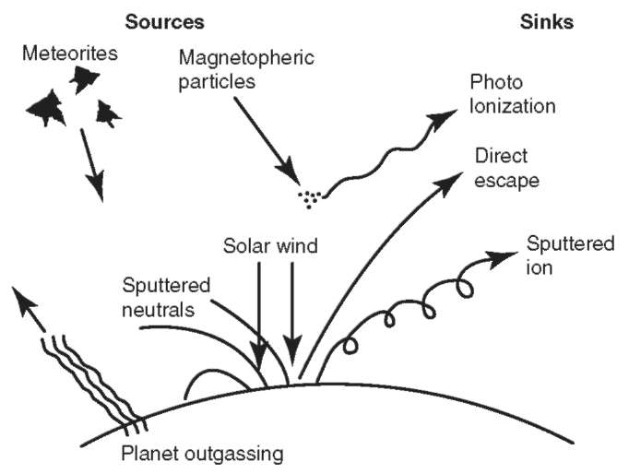
Figure 7. Surprisingly, Mercury has a tenuous atmosphere. This is not expected on a surface that is so hot. The sources and sinks of the atmospheric material is the subject of a lively debate within the scientific community. Possible sources could be slow outgassing from the planet itself. Furthermore, the solar wind probably plays an important role in creating Mercury’s atmosphere as the solar wind particles strike the surface and sputter material into the atmosphere. Cometary and meteoric material may be falling on the surface in sufficient quantity that their small volatile components may be supplied to the atmosphere. The atmosphere may escape by a variety of processes. Hot particles have velocities high enough that they can escape the planet’s gravitational field directly. It is also possible that they may be hit by energetic particles from Mercury’s magnetosphere, which charges and captures them in the magnetic field.
Recent radar observations from Earth have suggested that the radar reflective properties of material near Mercury’s poles are similar to those of water ice (15). The prospect that a planet as close to the Sun as Mercury has ice caps (or any water at all) is quite intriguing. It has been argued that the ice may reside in permanently shaded regions near Mercury’s poles and may be the remains of primordial water that condensed on Mercury when the planet formed from the solar nebula. If the source of this ice is indeed primordial water, then Mercury must have remained in a remarkably stable orbit for the entire age of the solar system, never tilting either pole toward the Sun, despite catastrophic events such as the Caloris impact. This would be a highly remarkable circumstance.
Another possible source of water might be a rain of cometary material that is falling into Mercury from all directions. Material that falls at the pole may remain in the shade and may be only slowly eroded. The proposed polar water deposits may be a source of Mercury’s atmospheric oxygen and hydrogen. For example, it is possible that the shaded polar regions may contain another volatile species whose radar reflectivity is similar to that of water ice. The radar observations may be explained by the presence of volatile materials other than water. Sulfur, a cosmically abundant element, has been suggested as a possible volatile, that might explain the radar observations. Nevertheless, the suggestion of volatile condensates near Mercury’s poles implies a dynamic atmosphere driven by processes that are, at present, poorly understood.
Mercury’s atmospheric material may experience several diverse fates. The high-velocity particles may be lost to space directly by thermal escape, the slower moving particles may reimpact Mercury’s surface and become redeposited, or the neutral atoms may lose one or more electrons and become ionized and then leave the planet as a consequence of electromagnetic forces generated by the planet’s magnetic field and any electric fields present.
The Mercurian Magnetosphere
Mercury’s magnetic field is strong enough to trap charged particles about Mercury forming a magnetosphere that is a miniaturized version of Earth’s. When Mercury is at aphelion, far from the Sun, the magnetic field has sufficient strength to prevent the solar wind from reaching the planet’s surface. It is estimated that the solar wind standoff distance is between 1.1 and 3 Mercury radii. Magnetospheres constantly change in response to external conditions, most notably the activity of the Sun. However, the timescale for magnetospheric changes is much shorter for Mercury’s smaller magnetosphere than for Earth’s. Thus, combined studies of the two magnetospheres can give information on the response time of a planetary magnetosphere to perturbations.
In Earth’s case, the thick atmosphere provides the lower boundary of magnetospheric activity. Mercury, however, lacks a thick atmosphere; hence, the lower limit is provided by the surface of the planet itself. In fact, unlike Earth, a large fraction of Mercury’s magnetosphere is occupied by the solid surface of the planet. As a consequence, Mercury’s magnetosphere lacks several important features that play a significant role in Earth’s magnetosphere. This includes the inner radiation belts and the plasmasphere. The energetic particles in the Mercurian environment are principally the solar wind and from additional lesser contributions of cosmic rays and Jovian electrons.
The boundary between the solar wind plasma and the magnetospheric plasma is called the magnetopause. This boundary regulates the amount of solar wind energy that is deposited on the planet’s surface. As the Mariner 10 spacecraft passed through the magnetopause, the spacecraft magnetometer and ion plasma analyzers changed. The magnetic field strength and orientation changed as the pass-through occurred.
Mercury’s magnetic field is just strong enough to prevent the solar wind from reaching the planet’s surface except when solar activity is high or when Mercury is at perihelion, the point in its orbit that takes it closest to the Sun. In these instances, the solar wind reaches the surface directly. When this happens,the solar wind particles sputter particles directly from Mercury’s surface to its atmosphere and magnetosphere. Thus, the analysis of the magnetosphere is important for understanding the planet’s atmospheric and surface composition. It is impossible to measure the variation in the intensity of Mercury’s magnetosphere from Earth (14).
Obstacles to Exploration of Mercury
In the four decades that humans have had access to space, the combined efforts of the world’s spacefaring nations have produced only one spacecraft visit to Mercury. This occurred more than two decades ago in 1973 when NASA sent the Mariner 10 spacecraft to explore Venus and Mercury, the two planets of the inner solar system. Since then, other nearby objects have enjoyed the attention of the space programs of the United States, the former Soviet Union, the European Space Agency, and Japan, but Mercury has been ignored. From the dawn of the space age to the turn of the millennium, the United States sent more than 40 missions to explore the Moon, 20 to Venus, and more than 15 to Mars. By the end of the next decade, an armada of orbiting spacecraft will have been placed in orbit about Venus, Mars, Jupiter, and Saturn that will return detailed information about these planets and their environs on timescales of years. Mercury however, will still remain largely unexplored, despite its many mysteries. Figure 8 illustrates the number of missions that have been flown to the nearby planets and the Moon.
There are several explanations for this skewed emphasis. Exploring these questions provides interesting insights into the way the United States, the world’s leading space power, manages its responsibility to explore the solar system.
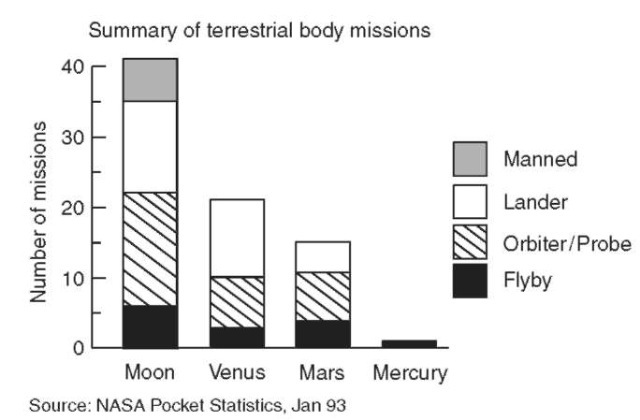
Figure 8. Summary of missions that have been flown to explore the terrestrial planets. Mercury is noteworthy in that it has been explored only once more than 20 years ago by the Mariner 10 spacecraft. This disparity in emphasis has occurred in spite of NASA’s commitment to a balanced program of space exploration where relatively equal emphasis is placed on exploring all of the planets.
A prominent obstacle to further Mercury research lies in the popular, but untrue, belief that Mercury is merely another lunar-like object. Ironically, this is in part due to the success of Mariner 10. That spacecraft returned television images of about 40% of Mercury’s surface, and they showed, to first order, that Mercury has a heavily cratered surface similar to that of the Moon. However, surface morphology is one of the very few similarities between Mercury and the Moon. These two objects have grossly differing physical attributes that suggest very different evolutionary histories. Unfortunately, because of the tremendous importance attached by human consciousness to visual images, there remains a widespread misconception that Mercury and the Moon are nearly identical objects, which by happenstance, occupy different regions of the solar system.
Another major hurdle to further exploration is technical. A spacecraft in orbit about Mercury must be protected, first, from the intense energy from the Sun, and second, as the spacecraft nears Mercury’s sunlit side, from the solar energy reflected from Mercury. At those times when the spacecraft is between the Sun and Mercury, the energy reflected from the planet’s surface can become a greater threat to the spacecraft than the Sun itself. It is flying between a frying pan and a fire. Maintaining spacecraft thermal stability in this situation is a major problem. The addition of thermal mitigation techniques increases the spacecraft mass and stresses the limits of the available launch vehicle technology, particularly if the spacecraft is to undertake its interplanetary cruise using conventional chemical bipropellants. However, the recent success of NASA’s New Millennium Deep Space One mission in demonstrating solar electric ion propulsion systems for spacecraft in deep space has demonstrated that alternative spacecraft propulsion techniques, such as ion drives, are feasible, can reduce the launch mass of a Mercury probe significantly, and can permit the mass of the science payload to increase. The next exploration of Mercury by the United States will still rely on conventional chemical bipropellant techniques, and this mission may provide limited answers to some of the questions that baffle us about Mercury. This will be immediately followed by a Mercury mission sponsored by the European Space Agency. This mission will be based on more modern technology. The solar electric propelled ESA mission will provide a significant advance in our knowledge of Mercury and will permit the scientific community to undertake intense comparative studies of Mercury and the other planets in the solar system. Such solar electric powered spacecraft can be expected to dominate the exploration of the inner solar system and to provide platforms to enhance our knowledge of difficult outposts such as Mercury.
